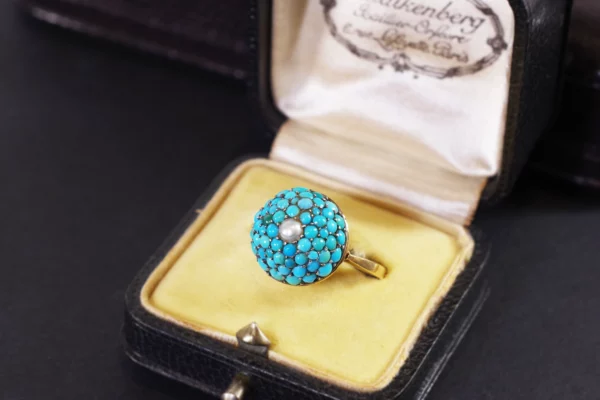Before 20th Century
95 Products
-
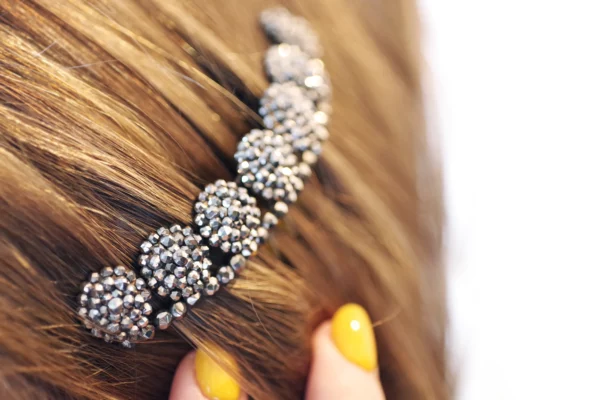
 480,00€
480,00€Steel-cut hair comb. This antique comb has five blond horn teeth. The top part slopes down and is decorated with a line of faceted steel-cut flowers. Antique hair comb, perfect for wedding hair accessories. Head jewel, France, early 19th century.
Dimensions: 7,5 cm x 8,5 cm
Condition: slight scratches, central flower moves slightly
Weight : 18.58 gr
Further info : In the 19th century dictionary of techniques: “Steel, thanks to its hardness, is susceptible to a beautiful polish; one forms very finely faceted half-pearls from it, and these steel points are riveted one against the other on silver-plated copper plates pierced with a thousand holes, which reproduce in silhouette the arrangements one wishes to execute.”
-
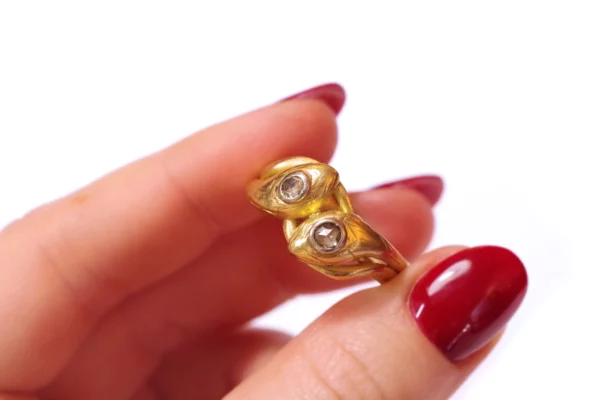
 1300,00€
1300,00€Victorian double snake ring in yellow gold 18 karats (750) and silver. This ring is made by two snakes wrapping around the finger. The heads of the two reptiles are surmounted by a Dutch rose-cut diamond. The heads are delicately chiselled and come to rest on the two rows formed by the body of the animal. Antique ring, France, Victorian period, late 19th Century.
Eagle head hallmark
Finger size : 63 EU or 10.25 US (can be resized)
Dimensions of the design : 11.7 x 18 mm Width of the head : 10 mm
Condition : scratches from use
Weight : 5 gr
*The antique box is not sold with the jewel*
-
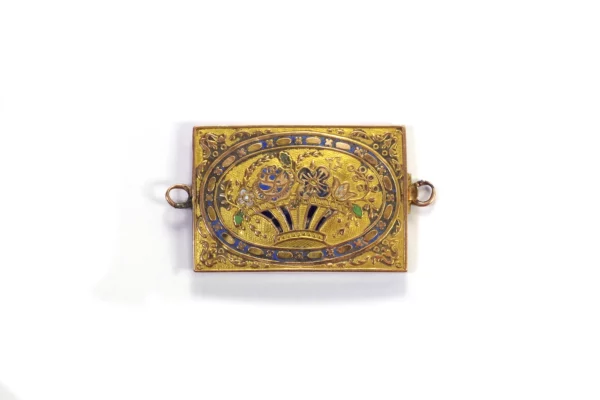
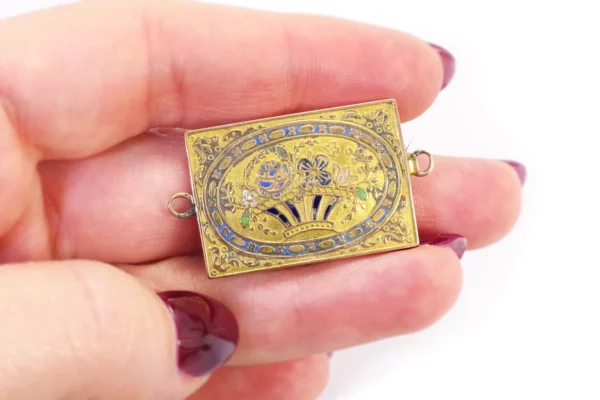 900,00€
900,00€Large French regional clasp in 18-karat rose gold (750) and 14k gold (for the clasp ring). This large Normandy clasp is made of hollow gold. It is richly decorated with colorful enamels. On one side, three partially enameled flowers blossom in the center of the clasp within a cartouche. The cartouche is surrounded by a frieze of dots and semicircles. On the other side, a flower basket composed of pansies, wheat, a rose, and a tulip is featured within a blue enameled cartouche. The presence of pansies is typical of the iconography of sentiment jewelry from the early 19th century, signifying “think of me.”
This Normandy regional clasp is a French sentiment jewel from the early 19th century.
Shell hallmark for standing clasp ring
Clasp Dimensions: 35 mm x 19 mm.
Condition: Scratches from use, missing enamels, slight indentations.
Weight: 3.30 gr
-
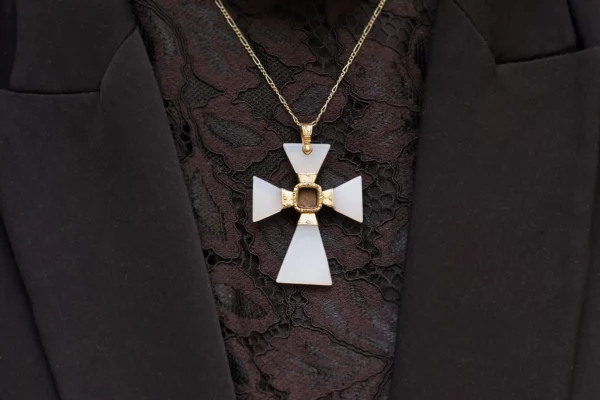
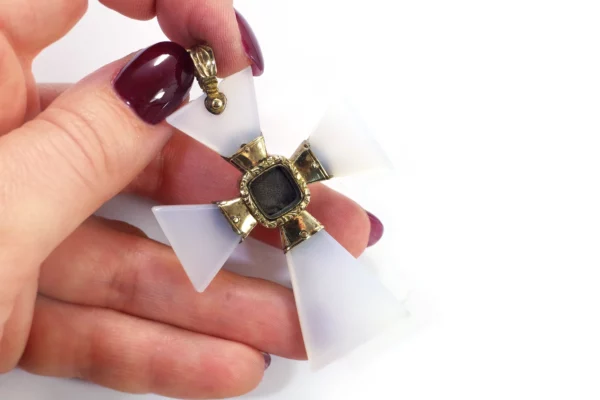 700,00€
700,00€Georgian Maltese cross chalcedony pendant in 9k gold. This antique reliquary cross is made of four chalcedony elements forming a cross, held together by a central gold element with delicate engraving. This central element likely originally contained a woven lock of hair beneath glass, although it is no longer present. The pendant has an intricately decorated bail. This Georgian cross t is from around 1820.
Trefoil hallmark
Dimensions: 60 x 34 mm.
Note: Similar Georgian Maltese crosses can be seen in the Victoria & Albert Museum in England.
Condition: Missing the central protective glass, some oxidation.Weight: 11.26 gr
*The antique gold chain is not sold with the jewel*
See our antique chains -

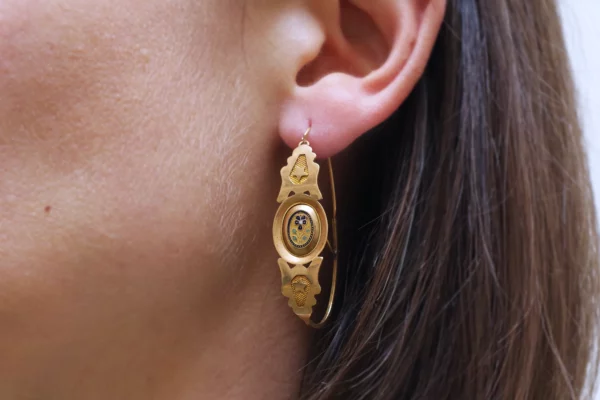 2400,00€
2400,00€Large enameled poissardes earrings in 18 karat rose gold (750). These substantial poissarde earrings are centered with a blue, green, and white enameled pansy, surrounded by a midnight blue enamel frieze punctuated with gold dots. The main motif is framed by two stars on a painted gold background. Poissardes, circa […]
-
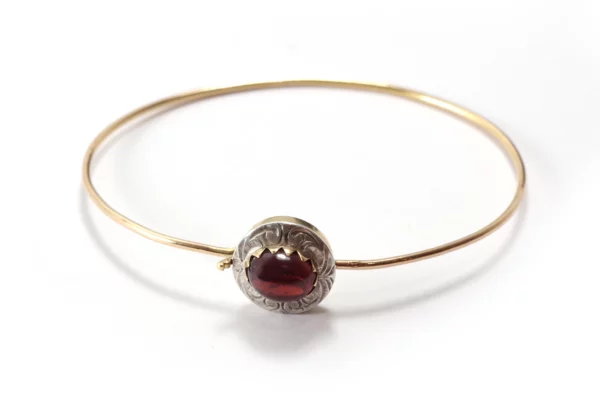
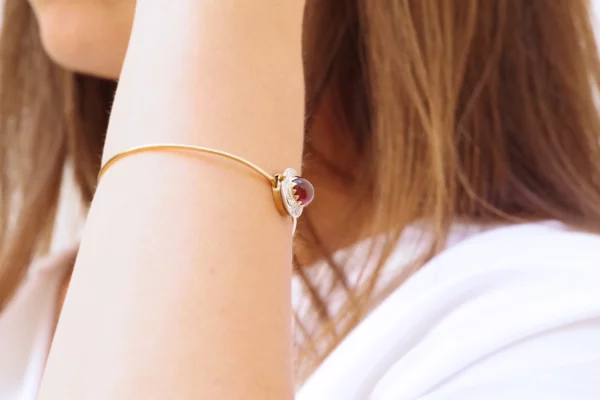 780,00€
780,00€Garnet bangle bracelet in 18-karat rose gold (750) and silver. This delicate bracelet forms a wire bangle, adorned with a circular element made of gold and silver serving as the clasp. The clasp is set with a significant cabochon garnet and features scroll motifs. The central element dates back to the 19th century and has been subsequently assembled into this fine bracelet.
Hallmarked with “charançons” (french state hallmarks for 18-karat gold) and a partially legible maker’s mark.
Inner circumference: 17 cm (approximately 6.7 inches)
Clasp dimensions: 14 x 13.8 mmCondition: Normal signs of wear, reassembly
Weight: 7.19 gr
-
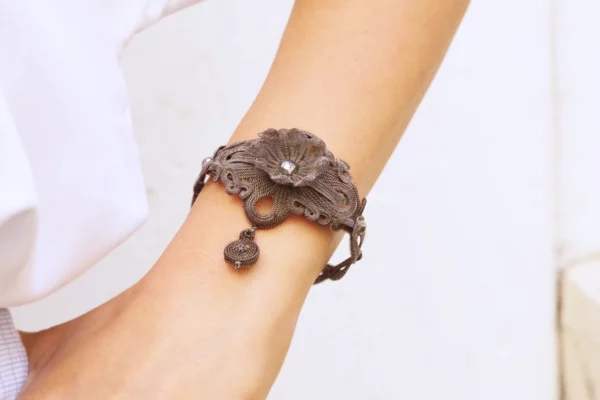
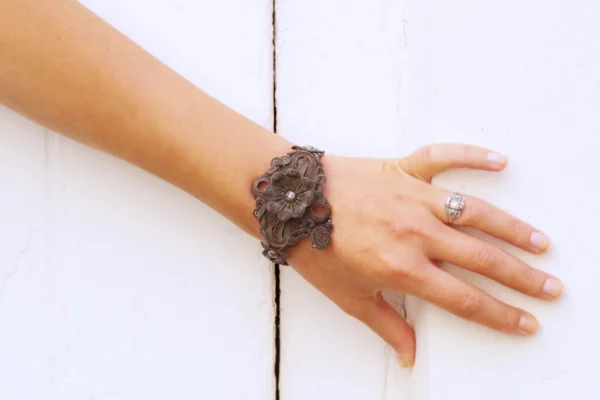 Out of Stock
Out of Stock
Georgian Silesian iron bracelet. Woven wire bracelet, decorated with a large flower, the heart centered on a faceted nail. A circular spiral pendant hangs from the flower. Antique bracelet, circa 1798/1800, Silesia, (region extending over parts of Poland, Germany and the Czech Republic) Dimensions: 7 cm (including pendant) x 22 […]
-

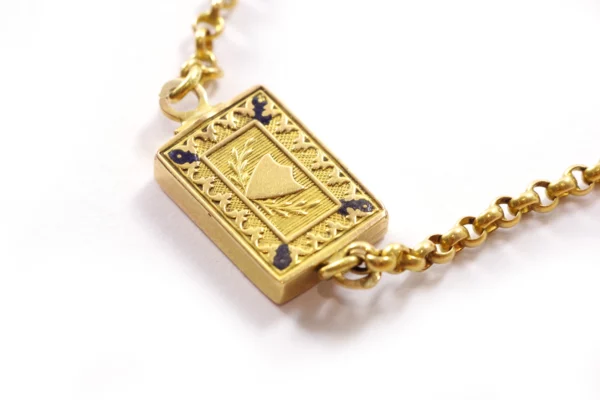 1400,00€
1400,00€French long necklace with enamel clasp and 14 karat (585) and 18 karat (750) rose gold. The 14 karat gold clasp is rectangular with two facets. The facets are decorated with enamels and motifs: one centred on a shield framed by two laurel leaves, the corners enamelled blue; the other decorated with a frieze of triangles enamelled blue, the corners enamelled white. The 18 karat gold sautoir chain is made of jaseron mesh. French regional jewellery from the mid-19th century, Normandy region.
Shell head hallmarks on the clasp, chain tested 18 karats.
Dimensions of clasp: 8 mm x 12 mm
Length of necklace: 70 cmCondition: missing enamel, scratches from use
Weight : 8.09 gr
-
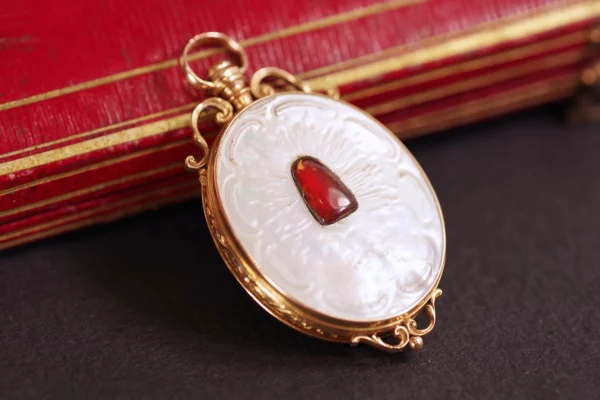
 1800,00€
1800,00€Antique reliquary locket pendant in 18k rose gold (750). On one side, the pendant is decorated with a miniature on paper depicting Saint Jerome praying before a cross, with a skull in the foreground. The miniature is protected by a beveled oval glass. The reverse features a chased oval mother-of-pearl plate adorned with a carnelian cabochon on red foil, set in the center of the composition. It forms the heart of Christ, in a radiating motif engraved in the mother-of-pearl. The medallion is decorated with fine chasing on the edge, which opens secretly by unscrewing the ring-like upper part. Antique medallion, probably French, dating from the late 18th century.
Owl hallmark (later add).
Dimensions: 43 mm x 25 mm
Condition: vellum miniature in poor condition, possibly restored or removed. Scratches from use.
Weight : 12.49 gr
*The antique box and the chain are not sold with the jewel*
See our antique chains -
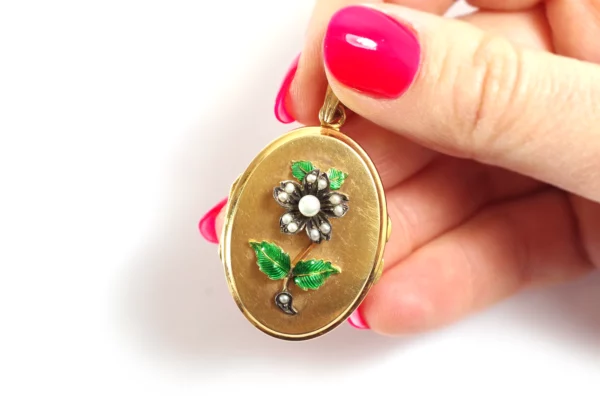
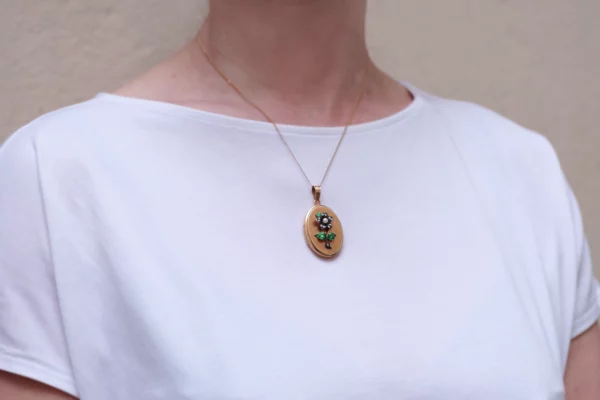 1100,00€
1100,00€Victorian flower locket pendant in rose gold 18 karats (750) and silver. Antique locket pendant with an oval shape decorated with a flower in relief, made of silver and gold, set with fine pearls. The leaves are in green enamel. The pendant opens onto a compartment that can hold a photograph protected by a glass. 19th century memento souvenir pendant.
Eagle head hallmark
Dimensions (including the clasp) : 45 mm x 25 mm x 5 mm
Condition : scratches from use
Weight : 11.06 gr
*The antique box and the chain are not sold with the jewel*
See our antique chains -
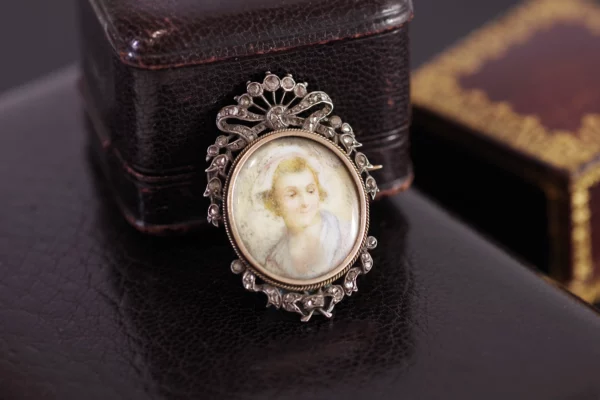
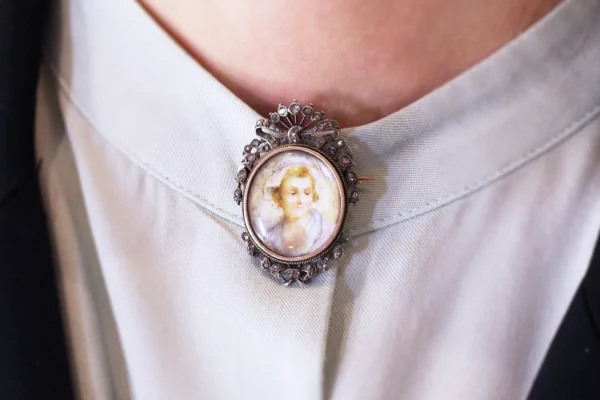 620,00€
620,00€Victorian portrait diamonds brooch in silver and rose gold 18 karats (750). Antique brooch with a lady’s portrait painted on ivory and protected by a glass. The portrait is surrounded by a pink gold border and a silver decoration forming a knot and foliage, set with 54 rose-cut diamonds. Late 19th century antique portrait brooch, Victorian period.
Owl and swan hallmarks
Dimensions : 35 x 25 mm
Dimensions of the portrait : 21 x 18 mmCondition : tiny scratches.
Weight : 7.20 gr
*The antique box is not sold with the jewel*


